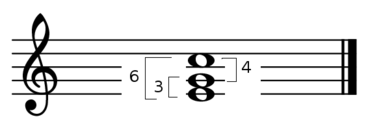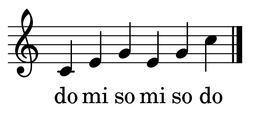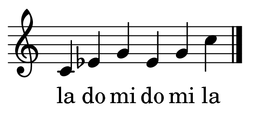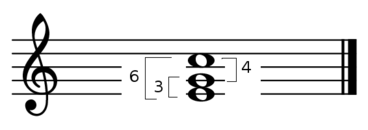The previous articles in the series have covered how to recognize the different qualities of triad – major, minor, augmented and diminished. Not only can we learn to hear the quality of triads, we can learn to hear their inversion. First we will briefly review the basic theory of inversions.
Inversions
Triads are made up of three pitches, a root, third and fifth. It is possible for any of its members to be the lowest note. A triad, therefore, has three possible positions, or “inversions”: root position, first inversion and second inversion, with the root, third, or fifth respectively, as the lowest note:

The three inversions of a triad
We spent quite a bit of time working on root position triads in an earlier article. We will begin studying inversions by first considering their interval content from the lowest pitch to the highest.
As we already know, root position triads contain stacked thirds, and a fifth from the root to the highest member. As we saw before, it is the quality of these intervals that determines its type.
We can observe a similar idea with inversions. A first inversion triad has a third between the lowest and middle pitch, a fourth between the middle and highest pitch and a sixth between the lowest and highest pitch:

The intervals in a first inversion triad
Training to hear inversions
This is a good place to start training. First, let’s get the sound of first inversion major and minor triads in our head. Give yourself a starting pitch and sing a major triad as follows, paying attention to the size of the intervals. Sing through the chord in root position, then arpeggiate up to its first inversion:

Singing up to the first inversion
We can do the same with minor triads:

Singing up to the first inversion of a minor triad
First inversions
Now lets compare root position triads to first inversion ones. In the following exercise, we will present a series of root position and first inversion triads. Do not concern yourself with their quality just yet. Simply listen to the chord, sing it back, and determine its position based on the size of its intervals. Root position triads will be stacked thirds, first inversion ones will be a third plus a fourth:
If you can sing back the above triads, and are reasonably comfortable with thirds and fourths, the above exercise is surprisingly easy. We should repeat the above exercise with block chords. There will be a slight pause between each chord to give you time to pull out the pitches. You may want to stop the playback after each chord to give you some time to think about what you have just heard:
We should now consider the quality of these chords in the above two examples. First lets look at their structure again. A major triad in root position will have a major third plus a minor third You can also check the fifth – its quality is perfect. In first inversion, the chord will have a minor third, plus a perfect fourth. The interval from the lowest note to the highest is a minor sixth:

Hearing the quality of a first inversion major triad
A minor triad will have a minor third plus a major third in root position.. The root to the fifth is a perfect fifth. In first inversion, it will have a major third on the bottom. The sixth is major:

Hearing the quality of a first inversion minor triad
Return now to the previous two exercises and see if you can determine not only each chord’s position, but also its quality.
Second inversions
Second inversion triads have the fifth of the chord as the lowest note. In close position, we can think of this position as a fourth plus a third. For both major and minor triads the fourth is perfect. The third is major for major triads, and minor for minor ones. The quality of the sixth is also major and minor respectively:

Second inversion major and minor triads
To get a feel for second inversion triads, give yourself a starting pitch and try these solfege exercises:
- Major triads: do mi so, mi so do, so do mi
- Minor triads: la do mi, do mi so, mi so do
In these two exercises you are simply arpeggiating through each of the positions of a major and minor triad.
In the next article we’ll continue with augmented and diminished triads. In the meantime, make sure you are familiar with the inversions of major and minor triads.









thanks, really appreciating this